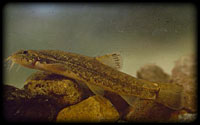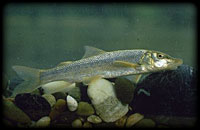|
|
In general, plant and animal life of Szamos is similar in character to that of the Tisza, but number of species and individuals are much below than that of the Tisza. High degree pollution leaves its mark on the image of the fauna: Szamos is perhaps the most polluted river of the Carpathian Basin. From section to section disappearing and partial regeneration of aquatic habitats is characteristic. Below the springs many sensitive invertebrates can be found, e. g. in the Meleg-Szamos the snail species Ancylus fluviatilis, or in Nagy Szamos the ephemerid Rhithrogena semicolorata kérészfaj. Within ephemerids (Ephemeroptera) the dominance of families Baetidae and Heptageniidae is characteristic. After the union of the Hideg- and Meleg-Szamos, in Kis-Szamos by industrial and communal pollution if Kolozsvár (Cluj Napoca) organic matter loading increases considerablely, which results in the extinction of the major part of the original fauna. Degradation is marked by the presence of only pollution tolerant species, the reddish-brown ephemerid (Ephemerella ignita) and a snail, Physa acuta in lower number of individuals. Below the spring of Nagy-Szamos, water is clear, but timbering and lumber processing changes the character of the river below the inflow. Because of the textile works and communal sewage of Naszód (Năsăud), life in the river decreases considerablely, and below Bethlen (Beclean) the river becoms dead. In the united Szamos the cellulose works and paper factory of Dézs (Dej) are considerable sources of pollution. Below this the picture of the river shows an improving tendency thanks to self clearing, after the inflow of Lápos (Lăpuş), however load of heavy metals, xenobiotics and organic matter, water quality deteriorates considerablely. Mining, heavy industrial and communal sewages of Kapnikbánya (Cavnic) and Nagybánya (Baia Mare) flow into the Lápos without cleaning. The last mor important source od pollution is Szatmárnémeti (Satu Mare). Below this invertebrate fauna is characterized by extreme deficiency in species, what inproves only in the environs of the mouth, where the effect of the Tisza already preveals to some extent.

 Fish fauna of Szamos reflects also a large scale human influence. Number of species is as low as 42. In Kis Szamos, though in a decreasing number of individuals, we can find the sensitive Carpathian endemic Carpathian lamprey (Eudontomyzon danfordi). Below Kolozsvár due to pollution fishes are practically absent at all. Nagy-Szamos shows a more favourable picture, on the uppermost course we can find the characteristic species of the trout level: brown trout (Salmo trutta fario), minnow (Phoxinus phoxinus), stone loach (Nemachilus barbatulus), on lower parts by the above mentioned timber industry species of higher oxygen demand appear again schneider (Alburnus bipunctatus), Balcanic barbel (Barbus meridionalis petenyii), Kessler's gudgeon (...). Thanks to polluton decreased number of species and individuals peculiar to the united Szamos too. Frequency of more sensitive, more specialized species decrease, or they disappear. Such species among rheophilous ones are Dace (Leuciscus leuciscus) and sterlet (Acipenser ruthenus), and Grayling (Thymallus thymallus), nose (Chondrostoma nasus), barbel (Barbus barbus), balcanic barbel (Barbus meridionalis petenyi), zingel and streber (Zingel zingel and Z. streber, respectively), and among spagnophilous species mud loach (Misgurnus fossilis), tench (Tinca tinca), crucian carp (Carassius carassius) and European mudminnow (Umbra krameri). Beside these the proportion of more euryecic species increase, such as bleak (Alburnus alburnus), asp (Aspius aspius), whitefin gudgeon (Gobio albipinnatus), and perch (Perca fluviatilis). It is characteristic to the lowermost part of the river, that its fish fauna consists of species preferring primarily more eutrophic waters, in a greater proportion and quantity as natural.
Fish fauna of Szamos reflects also a large scale human influence. Number of species is as low as 42. In Kis Szamos, though in a decreasing number of individuals, we can find the sensitive Carpathian endemic Carpathian lamprey (Eudontomyzon danfordi). Below Kolozsvár due to pollution fishes are practically absent at all. Nagy-Szamos shows a more favourable picture, on the uppermost course we can find the characteristic species of the trout level: brown trout (Salmo trutta fario), minnow (Phoxinus phoxinus), stone loach (Nemachilus barbatulus), on lower parts by the above mentioned timber industry species of higher oxygen demand appear again schneider (Alburnus bipunctatus), Balcanic barbel (Barbus meridionalis petenyii), Kessler's gudgeon (...). Thanks to polluton decreased number of species and individuals peculiar to the united Szamos too. Frequency of more sensitive, more specialized species decrease, or they disappear. Such species among rheophilous ones are Dace (Leuciscus leuciscus) and sterlet (Acipenser ruthenus), and Grayling (Thymallus thymallus), nose (Chondrostoma nasus), barbel (Barbus barbus), balcanic barbel (Barbus meridionalis petenyi), zingel and streber (Zingel zingel and Z. streber, respectively), and among spagnophilous species mud loach (Misgurnus fossilis), tench (Tinca tinca), crucian carp (Carassius carassius) and European mudminnow (Umbra krameri). Beside these the proportion of more euryecic species increase, such as bleak (Alburnus alburnus), asp (Aspius aspius), whitefin gudgeon (Gobio albipinnatus), and perch (Perca fluviatilis). It is characteristic to the lowermost part of the river, that its fish fauna consists of species preferring primarily more eutrophic waters, in a greater proportion and quantity as natural.